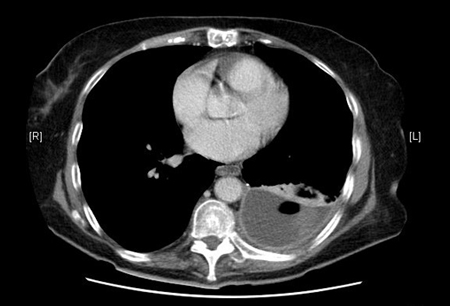Summary
Definition
History and exam
Key diagnostic factors
- recent pneumonia
- constitutional symptoms
- pyrexia and rigors
- dullness to percussion
- reduced breath sounds and reduced vocal resonance
- signs of sepsis
Other diagnostic factors
- subacute presentation
- productive cough
- pleuritic chest pain
- dyspnea
- recent instrumentation of the pleural space
Risk factors
- pneumonia
- iatrogenic interventions in the pleural space
- thoracic trauma
- immunocompromised state
- comorbid lung disease
- male sex
- older or young age
Diagnostic tests
1st tests to order
- blood cultures
- CRP
- WBC count
- metabolic panel
- chest x-ray
- thoracic ultrasound
- thoracentesis: pleural fluid appearance
- thoracentesis: pleural fluid odor
- thoracentesis: pleural fluid pH
- thoracentesis: pleural fluid total protein concentration
- thoracentesis: pleural fluid LDH level
- thoracentesis: pleural fluid glucose concentration
- thoracentesis: pleural fluid white cell differential
- thoracentesis: pleural fluid microscopy, culture, and sensitivity
Tests to consider
- contrast-enhanced thoracic CT
- MRI of thorax
- PET scan
- pleural fluid polymerase chain reaction (PCR)
Treatment algorithm
adults (culture results pending)
children (culture results pending)
adults (culture results available)
children (culture results available)
Contributors
Authors
Christopher Kapp, MD
Assistant Professor of Medicine, Interventional Pulmonologist
Division of Pulmonary and Critical Care, Section of Interventional Pulmonary
Northwestern Memorial Hospital
Chicago
IL
Disclosures
CK declares that he has no competing interests.
Jeremy Kim, MD
Instructor of Medicine, Interventional Pulmonology Fellow
Division of Pulmonary and Critical Care, Section of Interventional Pulmonary
Northwestern Memorial Hospital
Chicago
IL
Disclosures
JK declares that he has no competing interests.
Acknowledgements
Dr Christopher Kapp and Dr Jeremy Kim would like to gratefully acknowledge Dr Athanasia D. Pataka, Dr Renata L. Riha, Dr Najib M. Rahman, and Dr Eleanor K. Mishra, previous contributors to this topic. ADP, RLR, and EKM declare that they have no competing interests. NMR declares that Roche UK supplied clinical trial supplies and funding for the MIST2 trial that he conducted.
Peer reviewers
Steven Sahn, MD
Professor of Medicine and Director
Division of Pulmonary/Critical Care/Allergy/Sleep Medicine
Medical University of South Carolina
Charleston
SC
Disclosures
SS declares that he has no competing interests.
Nicholas Maskell, MD
Senior Lecturer and Consultant Physician
North Bristol Lung Centre
Southmead Hospital
Bristol
UK
Disclosures
NM declares that he has no competing interests.
Y.C. Gary Lee, MBChB, PhD, FCCP, FRACP
Consultant Chest Physician and Senior Lecturer
Oxford Centre for Respiratory Medicine and University of Oxford Churchill Hospital
Oxford
UK
Disclosures
YCGL declares that he has no competing interests.
Peer reviewer acknowledgements
BMJ Best Practice topics are updated on a rolling basis in line with developments in evidence and guidance. The peer reviewers listed here have reviewed the content at least once during the history of the topic.
Disclosures
Peer reviewer affiliations and disclosures pertain to the time of the review.
References
Key articles
Shen KR, Bribriesco A, Crabtree T, et al. The American Association for Thoracic Surgery consensus guidelines for the management of empyema. J Thorac Cardiovasc Surg. 2017 Jun;153(6):e129-46.Full text Abstract
Maskell NA, Davies CW, Nunn AJ, et al. UK controlled trial of intrapleural streptokinase for pleural infection. N Engl J Med. 2005 Mar 3;352(9):865-74.Full text Abstract
Canadian Paediatric Society. Paediatric complicated pneumonia: diagnosis and management of empyema. Jan 2024 [internet publication].Full text
Reference articles
A full list of sources referenced in this topic is available to users with access to all of BMJ Best Practice.

Differentials
- Pneumonia
- Uncomplicated parapneumonic effusion
- Lung abscess
More DifferentialsGuidelines
- ACR Appropriateness Criteria: radiologic management of infected fluid collections
- The American Association for Thoracic Surgery consensus guidelines for the management of empyema
More GuidelinesPatient information
Pneumonia
More Patient informationVideos
Pleural aspiration animated demonstration
Insertion of intercostal drain, Seldinger technique: animated demonstration
More videosLog in or subscribe to access all of BMJ Best Practice
Use of this content is subject to our disclaimer